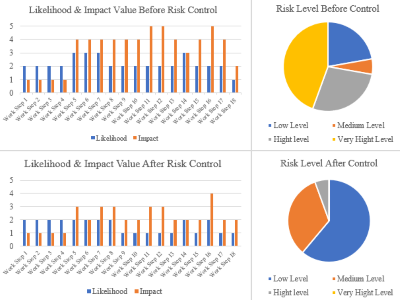Risk Control of Work Accidents in the Overpass Steel Box Girder Erection Work Process with JSA and HIRADC Methods
DOI:
https://doi.org/10.24036/cived.v12i1.724Keywords:
Risk Control, Job Safety Analysis (JSA), HIRADC, ; Erection Steel Box GirderAbstract
The construction of bridges, flyovers, overpasses, and other types of crossing structures is increasing along with the increasing volume of traffic. One important aspect of this development is the Girder Erection process, which is highly risky because heavy equipment and materials are in direct contact with workers. This study aims to analyze the risk of work at each stage of the construction of the Steel Box Girder Overpass Balaraja Barat B Tangerang City using the Job Safety Analysis (JSA) and Hazard Identification Risk Assessment and Determining Control (HIRADC) methods. This analysis covers each stage of work, starting from preparation, crawler crane setup, Steel Box Girder assembly, and Erection. The results showed 5 jobs with low-risk levels, 6 jobs with high-risk levels, and 7 jobs with very high-risk levels. In the research findings, the factor that causes the dominance of high and very high-risk levels is due to the impact of the risks that arise many of which have a very fatal impact so that they can cause large material losses and can cause casualties. Therefore, the determination of risk control is carried out to reduce the risk level to a lower level. After controlling, the risk level results are 11 jobs with low-risk levels, 6 jobs with moderate risk levels, and 1 job with high risk.
Downloads
References
R. A. Machfudiyanto, S. Kim, Yusuf Latief, S. Nurul, and Naufal Budi Laksono, “Analysis of design-for-safety implementation factors in the Indonesian construction industry: A two-staged SEM-artificial neural network approach,” Heliyon, vol. 9, no. 11, pp. e21273–e21273, Nov. 2023, doi: https://doi.org/10.1016/j.heliyon.2023.e21273.
M. A. Khorasane, M. Alimohammadlou, K. Klockner, M. Kamalinia, and M. Jahangiri, “Identifying the influential contributing factors to micro-enterprises’ workplace accidents using a hybrid D-DEMATEL-IFISM method,” Expert Systems with Applications, vol. 200, p. 117059, Aug. 2022, doi: https://doi.org/10.1016/j.eswa.2022.117059 .
J. S. Peatie, Hasan Haroglu, and T. Umar, “Barriers to achieving satisfactory dropped objects safety performance in the UK construction sector.,” Heliyon, vol. 10, no. 17, pp. e37413–e37413, Sep. 2024, doi: https://doi.org/10.1016/j.heliyon.2024.e37413.
J. Park, S. Seong, S. Park, M. Kim, and H. Y. Kim, “Multi-label material and human risk factors recognition model for construction site safety management,” Journal of Safety Research, vol. 91, pp. 354–365, Oct. 2024, doi: https://doi.org/10.1016/j.jsr.2024.10.002.
M. Yang, Y. Wang, R. Hammer, and P. Maresova, “Occupational health and safety management system and stock price crash risk,” International Review of Financial Analysis, vol. 93, p. 103141, May 2024, doi: https://doi.org/10.1016/j.irfa.2024.103141.
J. Xiao, W. Zhang, and R. Y. Zhong, “Blockchain-enabled cyber-physical system for construction site management: A pilot implementation,” vol. 57, pp. 102102–102102, Aug. 2023, doi: https://doi.org/10.1016/j.aei.2023.102102.
Novelin Tumatar and Bangun Marpaung, “Analysis of the Implementation of SMKK (Construction Safety Management System) Based on the Regulation of the Minister of PUPR No.10/2021 on the Construction Project of Coastal Safety Development,” pp. 437–444, Jan. 2023, doi: https://doi.org/10.5220/0012584400003821.
W. Qin, H. Li, W. Li, C. Han, X. Ji, and J. Gu, “A proactive driving risk assessment on mountainous two-lane roads considering opposite-direction vehicle interactions from video-based trajectories,” Computers & Industrial Engineering, pp. 110848–110848, Jan. 2025, doi: https://doi.org/10.1016/j.cie.2024.110848.
L. Kopenhafer et al., “Patient experience and unmet needs in high-risk nonmuscle-invasive bladder cancer: Insights from qualitative interviews and a cross-sectional survey,” Urologic Oncology Seminars and Original Investigations, vol. 42, no. 3, pp. 70.e1–70.e10, Jan. 2024, doi: https://doi.org/10.1016/j.urolonc.2024.01.013.
M. Valasik, “Gang injunction, What’s your function? Investigating the relationship between civil gang injunctions and gang associates’ patterns of association,” Journal of Criminal Justice, vol. 96, p. 102339, Jan. 2025, doi: https://doi.org/10.1016/j.jcrimjus.2024.102339.
Y. Xin, Y. Xin, X. Huang, and L. Xu, “Coping strategy of independent directors for job-fulfillment risk under different ownership types and enforced legal environments,” China Journal of Accounting Research, vol. 17, no. 4, pp. 100392–100392, Oct. 2024, doi: https://doi.org/10.1016/j.cjar.2024.100392.
Y. Guo, Y. Sun, Q. Si, X. Guo, and N. Chen, “Probabilistic Risk Assessment of Civil Aircraft Associated Failures under Condition-based Maintenance,” Reliability Engineering & System Safety, pp. 110550–110550, Oct. 2024, doi: https://doi.org/10.1016/j.ress.2024.110550.
B. Arnaud et al., “Status Of Infection Prevention And Control In Cameroon Healthcare Facilities: Lessons Learned From The Who Covid-19 Scorecard Tool Under The Hierarchy Of Control Model,” Infection Prevention in Practice, vol. 6, no. 4, pp. 100407–100407, Oct. 2024, doi: https://doi.org/10.1016/j.infpip.2024.100407.
Vahid Hajipour, D. D. Caprio, F. J. Santos-Arteaga, Amirali Amirsahami, and S. V. Noshafagh, “A two-stage stochastic programming model for comprehensive risk response action selection: A case study in Industry 4.0,” Expert Systems with Applications, pp. 125565–125565, Oct. 2024, doi: https://doi.org/10.1016/j.eswa.2024.125565.
J. Zhu, M. Saberian, J. Li, L. Wang, and T. Maqsood, “Turning crisis into opportunity: A comprehensive review on the application of personal protective equipment (PPE) waste in asphalt pavement construction for sustainable development,” Resources, Conservation and Recycling, vol. 211, p. 107857, Dec. 2024, doi: https://doi.org/10.1016/j.resconrec.2024.107857.

Downloads
Published
How to Cite
Issue
Section
License
Copyright (c) 2025 Muhammad Yoris Saeful Siesmax, Muhammad Oka Mahendra

This work is licensed under a Creative Commons Attribution 4.0 International License.







2.jpg)
